Being that half of our readers are in the architectural industry I wanted to share some of our pictures from the week in Japan for the BIMcloud® launch event. We also have some additional notes from the presentations and interesting sidebars to share.
GRAPHISOFT’s BIMcloud event was a two day orchestrated affair, with a planned set of excursions and first-class chaperoning to make sure its guests were well taken care of and getting to where they needed to be. The lead-up and excitement surrounding the BIMcloud press event was palpable on Day 1, where GRAPHISOFT Japan staff, led by Mr. Kenta Otsuka (Otsuka-san) and Mr. Tatsuro Kawai (Kawai-san), gathered up the press for a day of architecture touring and lunch. As we visited some excellent buildings (see pictures and links below) some of us writers kept whispering to each other, “what do you think they are going to announce?”
MORE: Special Event from Japan: GRAPHISOFT announces new ‘BIMcloud’ for global architectural industry
For the most part nobody really knew for sure what the Hungarian BIM software developer had in mind but one thing seemed unanimous: they were going all out for this event. At the time, it may have been a bit hard for its US and UK press group to get the point of all that effort, but after two weeks back home in Boston it all makes additional sense when looking at the global picture.
Notes First: Tour Pictures Second
The Global CAD Market: Trend and Size
Here is a note that is likely lost on the western market. Japan is the second largest CAD market in the entire world, and by a healthy margin. Only recently was Japan’s general economy eclipsed by China. If you want to see an interactive chart of the world’s 10 largest economies check out this fantastic link here. It also shows projections to 2019–something quite useful to global software players in technology driven countries. (see image 01)
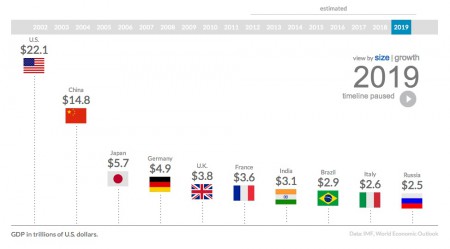
01 – Top 10 World Economies. Japan is the world’s second largest CAD market and will likely remain so even though China overtook Japan in 2010 in GDP.
At some point in the trip Viktor Varkonyi, CEO of GRAPHISOFT, noted that Japan’s AEC market is dominated by five corporate giants. Of those five giants four of them are firmly behind ArchiCAD as their BIM strategy. And of those five AEC giants, they control over 80 percent of all the AEC expenditure in Japan. It was also noted that BIM adoption in Japan lags the US, UK and some European countries, but that its largest companies have all outlined their aggressive BIM adoption roadmaps.
The way BIM will grow in Japan is from the giants out. That’s the reality and the key take-away.
In 2002, the US’s economy was $11.0 trillion USD. Next was Japan at $4.0 trillion. And then Germany at $2.0 trillion. If you play with the interactive chart mentioned above, notice what happens over time. Scrub through the years and notice the movement of the key players.
Here is a key summary (2002 – 2019 projected GDPs):
- China overtakes Japan as second largest economy in the world
- US continues to dominate all other world economies through 2019, doubling from 11 – 22 trillion USD
- Japan remains the firm leader of the remaining top 8 countries
- India, Brazil and Russia emerge, while Canada, Mexico and Spain fall off
While some of these countries’ economies equate to excellent opportunities for software firms others do not. China has a troubling piracy and intellectual property problem. Nikken Sekkei, one of the giants in Japan’s AEC market is establishing presence and expertise throughout Asia and in Russia. GRAPHISOFT’s top-down approach with gaining the trust and clientele of the AEC industry’s biggest customers in Asia may greatly mitigate many of the problems associated with selling software in China.
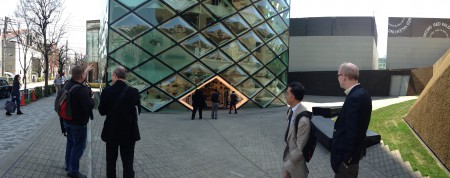
02 – Members of the press getting ready to stop by at the Prada store, designed by Herzog & de Meuron. Many more pictures below (keep reading…!)
Also of interest in the world’s largest economies is keeping eyes on Russia and Brasil. These two economies combined will have roughly the same size as Japan. Of course a country’s economy cannot be related to a CAD industry economy in a one-to-one ratio. Still, both Brasil and Russia seem like attractive markets for GRAPHISOFT. The company already has a branch office in Brasil. Could Russia be next?
One final note that deserves mentioning is this. Because only about 15 percent of architecture firms in Japan are doing BIM, the rest are still firmly stuck in the world of 2D CAD. Another press member assumed AutoCAD dominated that spot. But Viktor Varkonyi corrected noting that their biggest rival is likely sister company Vectorworks Inc, though AutoCAD is very common. This means that Nemetschek AG (the group) is likely in the leadership position in Japan– the world’s second largest AEC CAD market–as a whole when ArchiCAD and Vectorworks are taken together. (see footnote)
Architectural Tour
Getting back to the architectural tour, led by GRAPHISOFT of Japan, the press was handed an interactive map showing some of Tokyo’s coolest structures created by ArchiCAD-based AEC companies and some that are just cool and nearby. In addition to some superb buildings by Nikken Sekkei, we made stops to see buildings by Toyo Ito & Associates, Herzog & de Meuron and Kengo Kuma & Associates among others. (see image 03)
Our main architectural guide was Mr. Tatsuro Kawai (Kawai-san) of GRAPHISOFT Japan. We saw several buildings, including some in the upscale Minami-Aoyama district. Our first stop however was to Lidabashi Station urban redevelopment project featuring two 30-story towers. This project, designed by Nikken Sekkei and built by Maeda, one of Japan’s AEC giants, and entirely done as a BIM project, was under construction. After a BIM project presentation by Maeda staff we were led with hard hats to the roof top to gain views of the larger Tokyo skyline. (see images 04-06)
Another remarkable structure we visited was across town to the Jinbocho Theater, designed by Mr. Tomohiko Yamanashi (Yamanashi-san) of Nikken Sekkei. This structure is a very innovative performance theater space. Actually a set of spaces as it contains a 100-seat cinema plus a 126 seat play theater. The exterior is made of steel plates (see pictures 07-08) that creatively envelop a structure of glass. Its shape was determined by building out to the maximum allowed volume for the lot. In Japan due to its tight urban conditions zoning rules contain something called “planning height control planes” that ensure adequate sunlight for neighboring structures and plots. These planes may slant.
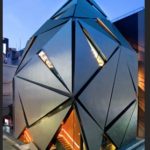
07 – This image is from the brochure Graphisoft provided us. Clearly a dramatic structure at night time. (courtesy of Graphisoft and Nikken Sekkei)
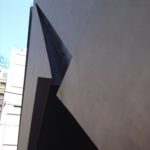
08 – Steel plates create both the wall planes and roof planes of this innovative theater structure. Nikken Sekkei, Architect.
After seeing the Jinbocho Theater we got back on the bus and zoomed over to the upscale Minami-Aoyama district. In this area high-end luxury brands compete for the attention of well-healed consumers with architectural showcases while unique restaurants offer additional environmental attraction.
Aside from Toyo Ito & Associates’s TOD’s structure, the press group was particularly drawn to notice Herzog & de Meuron’s Prada building, a cellulose glassy bubble form with truly innovative construction. (see pictures….) Also nearby was the INTERSECT BY LEXUS building, where we lunched, and Dior building by Kengo Kuma & Associates. (see images 09-14)

13 – Another shot of the interior of the LEXUS branded experience building. A wall of car parts in a white painted collage formed a backdrop.

14 – Though not officially on our tour this interesting BOSS brand store featured curved (bent) vertical struts of cast concrete intermixed with glass curtain wall.
The INTERSECT BY LEXUS building was designed by famed Tokyo designer Masamichi Katayama of Wonderwall. An article in the New York Times discusses his early work and design aesthetic. The LEXUS building aims to recreate the design ethos of the Lexus car brand in a building environment that mixes a club with a bar and restaurant. There is also a space for a Lexus car, in an interactive and engaging gallery.

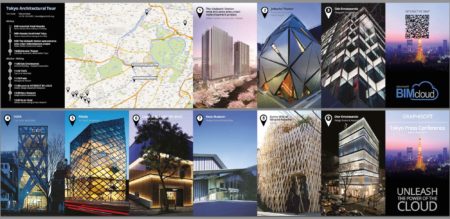


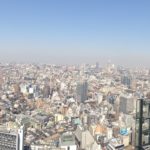
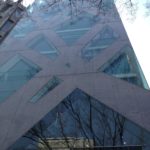
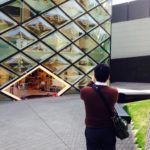
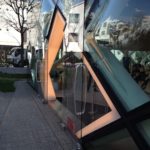



Reader Comments
James Badcock liked this on Facebook.
Matthew Ivanov liked this on Facebook.
Comments are closed.